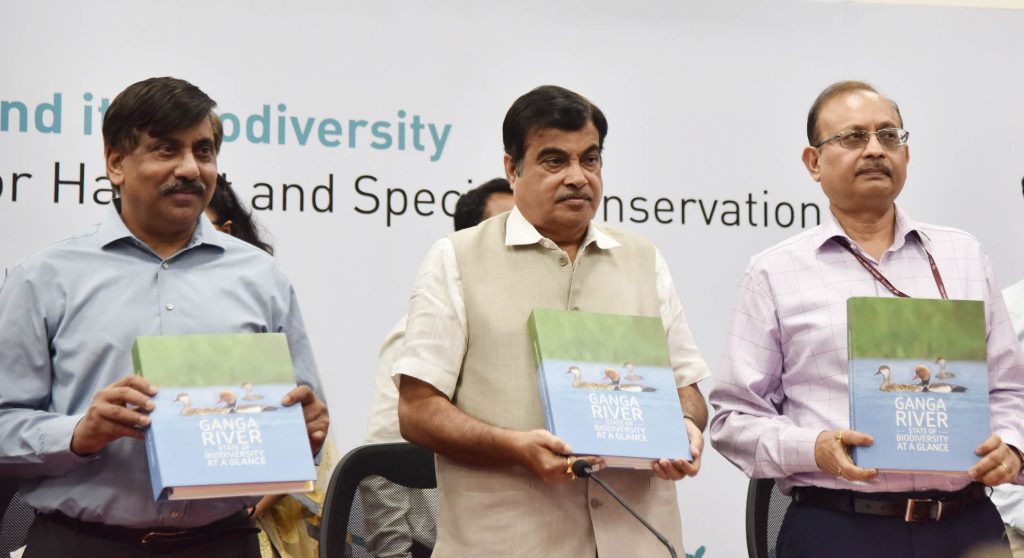India increasing activities like plantation on river bank, boating, construction of Mukti Dhams and Ghats
India increasing activities like plantation on river bank, boating, construction of Mukti Dhams and Ghats

NEW DELHI: India’s Water Resources, River Development and Ganga Rejuvenation Minister Nitin Gadkari released the report on ?Status of Conservation of Select Aquatic Species? in river Ganga in New Delhi today.nnHe also inaugurated a day-long workshop organized by World Wildlife Fund (WWF) on the theme ?Ganga and its Biodiversity: Developing a Road Map for Habitat and Species Conservation?. A database of Ganga Praharis?, a self-motivated cadre, being created by Wildlife Institute of India (WII) was also launched by the Minister.nnAddressing the gathering, Gadkari emphasized the need to approach the challenges of cleaning river Ganga through an ?integrated approach and with synergy between development and ecology.nnMentioning successful examples like making paper from bamboo, Gadkari said: ?Such activities will not only generate employment in areas near river Ganga but will also encourage local communities, some of whom have joined the clean Ganga mission as Ganga Praharis and Ganga Mitras, to ensure conservation of river?s biodiversity. We are increasing activities like plantation on river bank, boating, construction of Mukti Dhams and Ghats. These will increase employment opportunities and will mobilise public participation of the local residents in the task of cleaning Ganga?.nnU.P. Singh, Secretary, Ministry of Water Resources, River Development and Ganga Rejuvenation said: ?Ganga still has about 2,000 aquatic species and with the participation of one and all the difficult task of restoring Ganga?s biodiversity can be achieved.? He also pointed out that both aviralta and nirmalta of river Ganga are important and the government is committed to achieve both.nnThanking Ganga Praharis and Ganga Mitras for their voluntary support, DG, NMCG Rajiv Ranjan Mishra said: ?I hope that these volunteers which now number about 400 will increase to thousands and lakhs and Clean Ganga Mission will become a mass movement.? He hoped that discussions during today?s workshop between experts will yield some valuable suggestions and recommendations which will be fruitful for policymaking.nnThe Ganga Praharis?, a self-motivated volunteer cadre from local communities have been trained and taken on board by National Mission for Clean Ganga (NMCG) and Wildlife Institute of India (WII) to make Clean Ganga Mission a mass movement. This cadre has been created to ensure the sustainability of efforts in conservation of the biodiversity in river Ganga. So far, 427 Ganga Praharis across five main stem Ganga basin states of Uttarakhand, Uttar Pradesh, Bihar, Jharkhand and West Bengal have been involved in this project.nnThe first-of-its-kind report ?Status of Conservation of Select Aquatic Species? which was released by the Minister present the status of select species of river Ganga and synthesize the information from available literature as well as from the data generated through the rapid biodiversity assessment of the river. This would make valuable contribution for making a baseline for these species.nnThe Minister also released another publication ?Ganga Biodiversity-At a Glance? which gives species with details, along with their depiction and maps.nnThese reports have been prepared by Wildlife Institute of India (WII), Dehradun as part of the ?Biodiversity Conservation and Ganga Rejuvenation? project being sponsored by National Mission for Clean Ganga (NMCG) under the aegis of the Namami Gange programme. The project aims to develop a science-based aquatic species restoration plan for Ganga by involving multiple stakeholders.nnThe technical session focused on ?Developing a Five and 10 year strategies for Ganga aquatic biodiversity conservation?. Six biodiversity hot spots have been identified covering 50% of the stretch of river Ganga with high conservation values. Discussions during the day-long workshop focused on developing appropriate strategies for these areas.nnDuring the rapid biodiversity assessment made under the project, species, such as Siebold?s smooth scaled water snake (Enhydris sieboldii), were observed after a gap of 70 years in river Ganga. The biodiversity assessment team also reported new nesting ground of Indian Skimmer (Rhynchops albicolis), a globally threatened bird, between Allahabad and Mirzapur, positive signs for the river?s biodiversity.nnAn exhibition was also put up during the event on Biodiversity Conservation in river Ganga depicting the journey so far and road map ahead.





